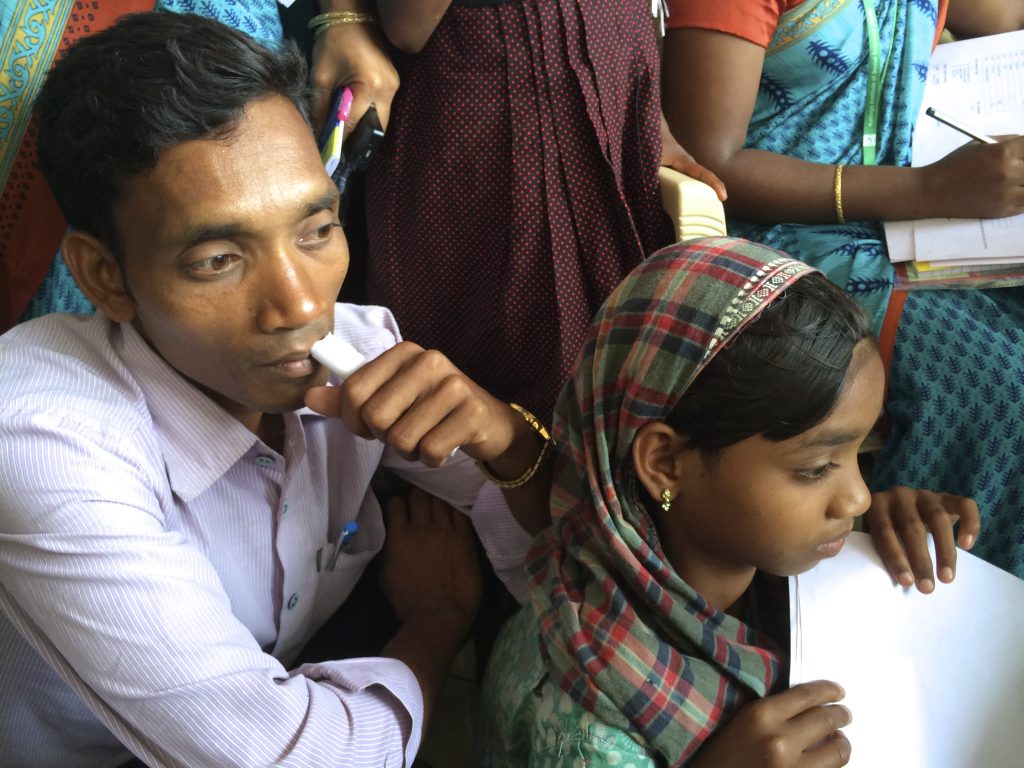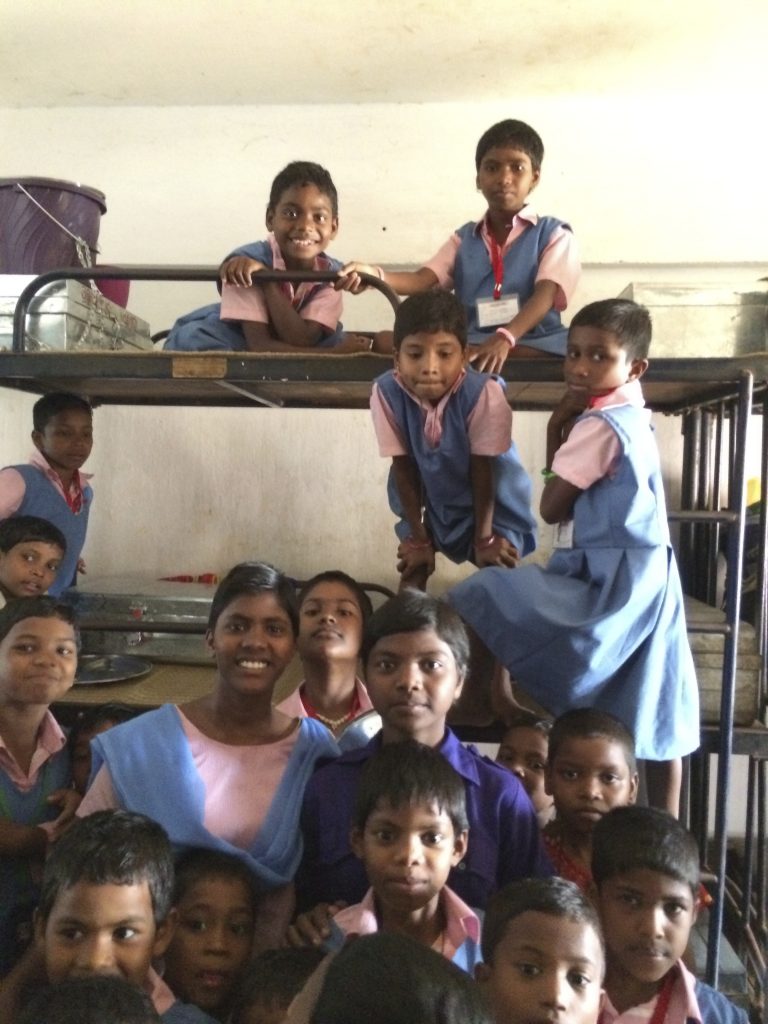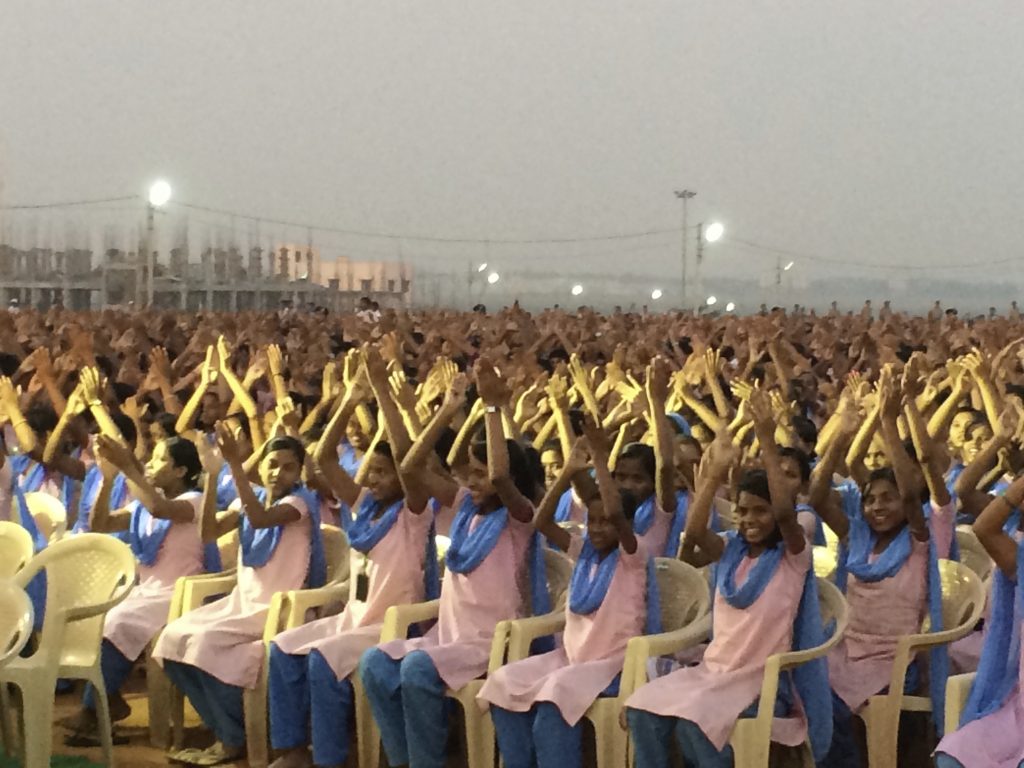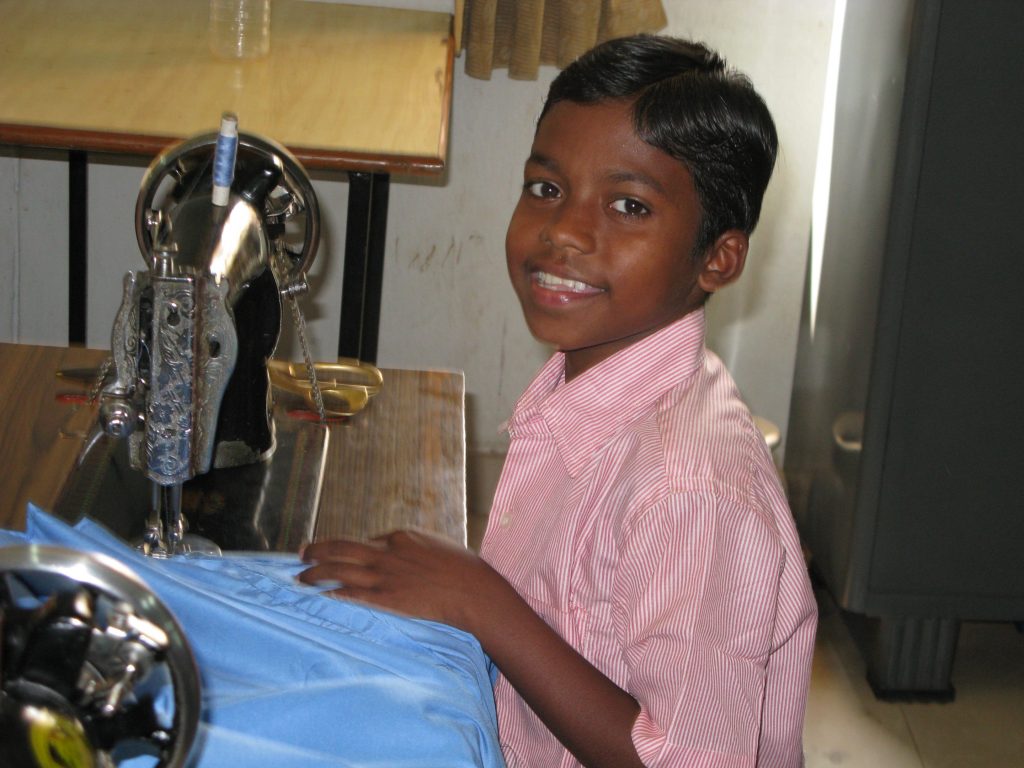Residential Schooling Brings Opportunity to India’s Poorest Indigenous Children

It’s a characteristically mild November afternoon in Bhubaneswar, India, around 5:30 p.m., and the fading daylight is softly filtered by an ever-present haze of dust and smog. Approximately 22,500 students, dressed in uniforms of muted pink tops and light-blue pants, sit patiently but expectantly. They have waited for nearly an hour to welcome the latest entourage of international guests—in this case, dignitaries from 23 countries. As word that the guests have arrived spreads, the students’ arms shoot up in unison, and they begin to clap out a thunderous, well-rehearsed welcome.
This event took place in 2014, but a similar scene plays out for students at the Kalinga Institute of Social Sciences (KISS)—the largest residential school for tribal children in the world—at least once a month. In the last five years, I have witnessed these stirring greeting ceremonies on many occasions. Each time, I have vacillated between getting caught up in the genuine enthusiasm that surrounds KISS and worrying about the impact on the children of growing up outside their tribal cultures and without the nurturing support of their families in a place where the student-to-adult ratio is 30-to-1.
In light of the horror stories of 19th- and 20th-century North American Indian residential schools and Australian boarding schools for Indigenous children, I wanted to be sure that the abusive teaching practices and forced assimilation that characterized those schools were not being repeated at KISS. In those schools, children were forcibly removed from their families and communities, indoctrinated with Christianity, and typically allowed to speak only English. The children were taught that their native cultures were inferior, and they were not allowed to speak their native languages.
The shadow of this dark history has a long reach. Thus I wanted to find out: Does KISS empower Indigenous children or leave them uprooted and cut off from their cultures and families—forever lost in an in-between where they are neither part of the wider Indian society nor part of their home communities?
I spent six months at KISS in 2014–15 as a Fulbright research scholar to obtain as many stories about the school and its effects as possible. Three Indian research partners and I interviewed 160 students, former students, parents, staff, teachers, administrators, and visitors. We observed classes, meal times, celebrations, and sporting events, and we visited several tribal villages. I wanted to know why parents in these villages send their children so far away to go to school and whether there aren’t acceptable noninstitutional alternatives closer to home. I wanted to learn what children gain—and lose—from growing up at KISS. I also sought to explore the core beliefs, values, and assumptions that bind this school community together.
KISS sits near India’s east coast in the state of Odisha, which, along with Bihar, is one of the two poorest states in India. Some 22 percent of Odisha’s population is Indigenous. The institute now supports 25,000 students from grades one through graduate training who are drawn from 62 different Indian tribal groups. Launched in 1993 with just 125 tribal children, the school ultimately aims to educate 2 million of India’s poorest children over the next decade, in part by setting up satellite campuses—in other districts within Odisha as well as in other Indian states. Children as young as age 6 travel here by bus or train from hundreds of miles away, parting with their parents and siblings for up to 10 months at a time. They go home to their villages only during the summer.
Academic classes, lodging, meals, medical care, and vocational and athletic training are free to all students admitted to KISS—parents pay only to get their children there. The school is funded almost exclusively by profits from its sister institution, the Kalinga Institute of Industrial Technology (KIIT), a well-respected private university, along with donations and a smattering of small grants from foundations. KISS receives no funding or support from the state or national government. Of the 50,000 annual applications, it can accept only about 2,000. Acceptance is not based on merit but on need. Simply put, the poorest of the poor, usually just one child per family, are chosen to attend KISS.
KISS meets a need where India’s government schools fail—at least that is what the school and many parents argue. Indigenous families in Odisha are as eager as other parents to send their children to good schools, but they have few choices. One father said, “In my village primary school teachers are not coming regularly, they attend school only two or three days in a month. Students attend school not to learn anything but only for midday meal. KISS is much better than our local school.” Private schools in India are popular, even among the relatively poor—some 40 percent of India’s students are enrolled in private schools. But few Indigenous families live in close proximity to private schools or are able to afford them.
It is not unusual for Indigenous children in India to attend residential schools. Government-run residential secondary schools are common in the tribal districts, serving the few students who come from outlying small villages to continue their education beyond the primary grades. However, the poor quality of government schools at all levels combined with family poverty leads to high dropout rates, especially among Indigenous students.
Most of the children who arrive at KISS come from villages with poor sanitation and little or no electricity or running water; in many cases, their whole village has been forcibly relocated by the government in order to make way for mining, logging, and dam construction. The mothers of KISS students are usually illiterate, having had no formal education; their fathers often receive schooling up to only fifth grade, and many can do little more than sign their names. Many Indigenous families are unable to consistently feed their children. For them, stepping onto the grounds of KISS—with its two- to three-story classrooms and dormitories and its sprawling playing fields—is an invitation to a brighter future.
Unlike now-shuttered Indigenous boarding schools in the West, students are not forced to attend KISS, and they are not stripped of their tribal cultures and languages; rather, parents eagerly seek out space for their children at KISS, and the school exhorts students to be proud of their heritage and to keep their languages and cultures alive. In reality, students inevitably lose some of their native language and cultural fluency through lack of use and exposure, and they are likely to assume that the languages used at KISS—and the beliefs, values, and behaviors needed to thrive there—are superior to those learned in their tribal villages.
As an anthropologist, this bothers me, but I also know that families all over the world make similar trade-offs when they relocate from rural villages to cities or immigrate to new countries in hope of a better life. Like these families, tribal parents understand that their children will be changed—in fact, that is their intent. One father proudly said that his son speaks both his tribal language and Odia, the state language used at KISS, but that his behavior has changed: “He is not behaving like a villager; now he behaves like an educated person.” In the best of worlds, these children join the ranks of those who are bilingual and bicultural.
The institute has drawn attention recently as word of its success has spread. This year, the Geneva-based media organization NGO Advisor rated KISS among the top 500 nongovernmental organizations (NGOs) internationally and the top 10 in India. In 2015, KISS became the seventh Indian NGO to be granted U.N. consultative status, and in 2014 its founder, Achyuta Samanta, received the Gusi Peace Prize International—sometimes described as the Nobel Peace Prize of Asia—for his personal sacrifice and tireless work to eradicate poverty through education. This external recognition supports the official stories of both KISS’ and Samanta’s extraordinary ability to overcome adversity in the pursuit of societal good. But it doesn’t speak to students’ actual experience of attending KISS, and I wanted to see if the reality lives up to the enthusiastic reviews.
One Saturday afternoon during my stay, I saw a boy singing a song in the company of about 50 classmates. The song, composed in Odia, described KISS and its founder in glowing terms—much like the tenor of the official narratives about the school. In a follow-up interview, we asked the boy what inspired the song. He explained that he had come to KISS a few years earlier as a young teen and that prior to coming here, he’d been going down the wrong path—drinking alcohol, skipping school, and getting in trouble. He said he composed the song as a tribute to KISS for giving him hope for a better life.
Several other students emphasized to us how glad they were to be at KISS. A number of them recalled stories about how bad the schools are in their villages. One KISS graduate told us that all of his friends back home were working as laborers at minimum wage. “If I had not come to KISS, I would be a laborer in my village,” he said. This student is studying for a college diploma in electronics and telecommunications, and he hopes to obtain a bachelor’s degree from KIIT and work as an engineer. Others aim to return to their districts as doctors, teachers, or nurses. The children at KISS are developing aspirations similar to those of middle-class children around the world.
Like the students, many of the teachers we met praised KISS and talked about how they chose to teach there because they were inspired by KISS’ commitment to poverty eradication and by Samanta’s sacrifice. At KISS, instructors are both teachers and parents, living in the on-campus dormitories with students or in off-campus housing close enough so they can be called back at any time. As one teacher described, “I don’t feel just like a teacher here but I feel it’s my home, and these are my own children. I live with the children and am involved in each aspect of their lives.”
Of the many students I interviewed, I encountered only a small handful who criticized the institute. Most of the criticisms were based on predictable issues like problems with friends and missing festivals back home. We heard about a group of four fifth-grade boys who ran away from KISS. But when we visited their village, we discovered that only one of the four was unhappy at KISS and that the others regretted leaving.
The KISS students made me realize that Westerners often underestimate children’s abilities to self-regulate and get along peacefully. KISS explicitly encourages responsibility, orderliness, and respect—and the children unquestioningly embody these behaviors. This ensures that all students are safe in their dorms, are fed three times a day, and have time and energy to attend classes, participate in extracurricular activities, and play. Where do they learn these behaviors? They absorb them through the cultural messages produced by KISS and also from each other—especially from older students. In short, the students learn to parent one another.
When KISS’ founder, Samanta, first envisioned the school in the early 1990s, he was deeply discouraged by the poverty that plagued Odisha—a way of life he knew firsthand. Samanta’s father was killed in a railroad accident when he was 4 years old, leaving his mother widowed with eight children. The family lived in extreme poverty, and he shared in the care of his mother and siblings by gathering wood and helping his mother scavenge for food. Through the kindness and generosity of a village elder, he was able to complete high school and pursue a master’s degree in chemistry, going on to teach at several colleges in Odisha.
Samanta was haunted by the plight of tribal people he encountered as he traveled the state. He was outraged at how they were treated when they sought help in district centers, and he vowed that these people’s children should not suffer from poverty as he had. In 1993 he founded the technical institute, KIIT University, and began channeling nearly all of his personal profits to support the launch of KISS. (In addition, employees from KISS and KIIT dedicate 3 percent of their salaries to support KISS.) Because of his commitment to poverty eradication, Samanta has been described as a “merchant of hope.”
It is this concept of hope that permeates the school’s culture. The students are repeatedly reminded that they are special, that they are destined to be change agents for their communities, and that through education they can rise out of poverty. Students at KISS develop the “capacity to aspire,” a concept introduced by sociocultural anthropologist Arjun Appadurai. By surrounding students with role models and offering them concrete plans for a better future, KISS avoids the false hope that too often characterizes the promises schools make to poor and vulnerable populations.
But while KISS does provide hope for students and their families, it is still fair to question if their sacrifices are worthwhile. Statistics on overall job placements, academic achievement levels, and dropout rates are currently unavailable. But pass rates for KISS students on state-mandated tests in grades 10 and 12 are higher than the state average and considerably higher than averages for tribal children. In 2015, for example, 100 percent of KISS students passed the 12th-grade exam in arts, science, and commerce, compared to 76 percent of students across the state.
In addition, KISS has many student success stories of scholars, ambassadors, and athletes. Each year, 5 percent of KISS graduates are admitted tuition-free to KIIT, which is a highly selective university. These students have the opportunity to study for careers in engineering, medicine, and law, among other subjects. KISS students also have opportunities to speak before international audiences, and a few students have been invited to participate in international events sponsored by organizations such as the United Nations. Examples of athletic achievements abound; one student qualified to train for the Indian 2020 Olympic archery team, and many teams compete internationally—the under-13 boys’ and girls’ rugby teams have won international competitions in the United Kingdom.
By the time my research at KISS was over, I was confident that the school is unlike the boarding schools for Indigenous children that are part of the painful legacies of North America and Australia. In this poor state in India, a young boy’s song rings true.




























